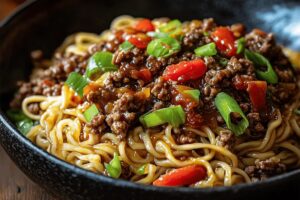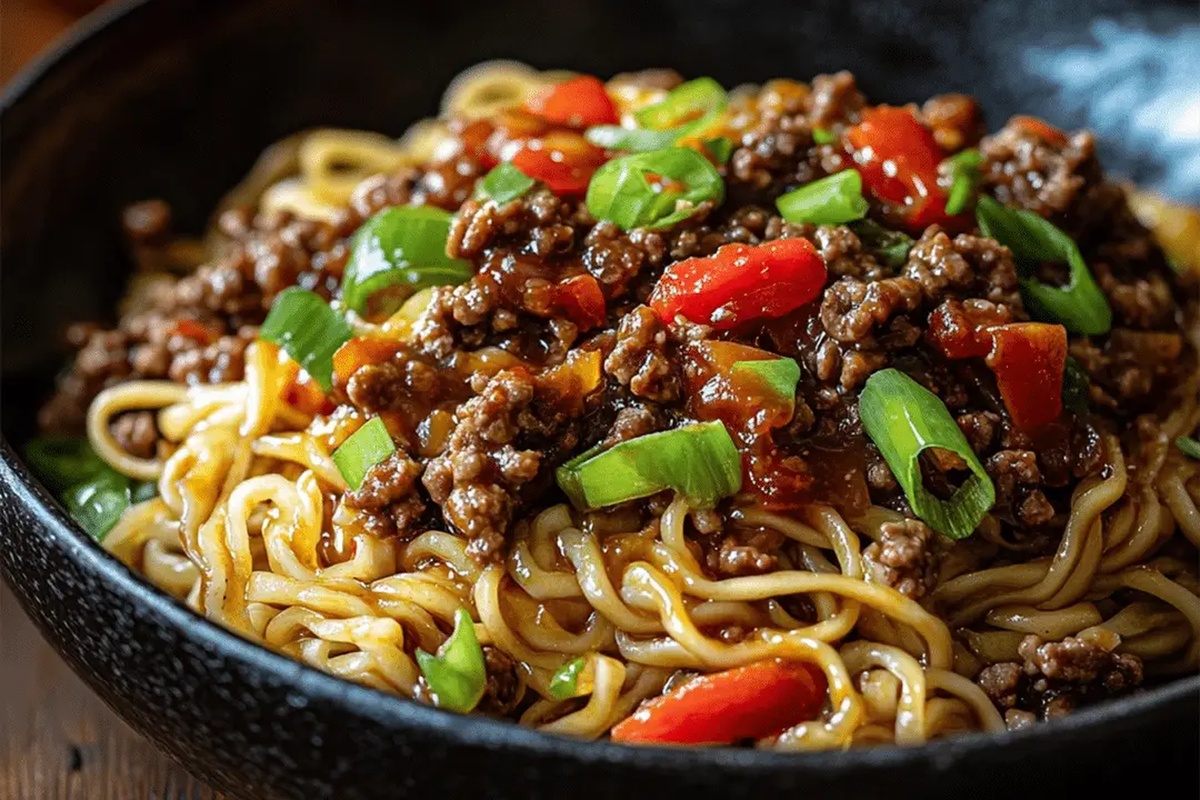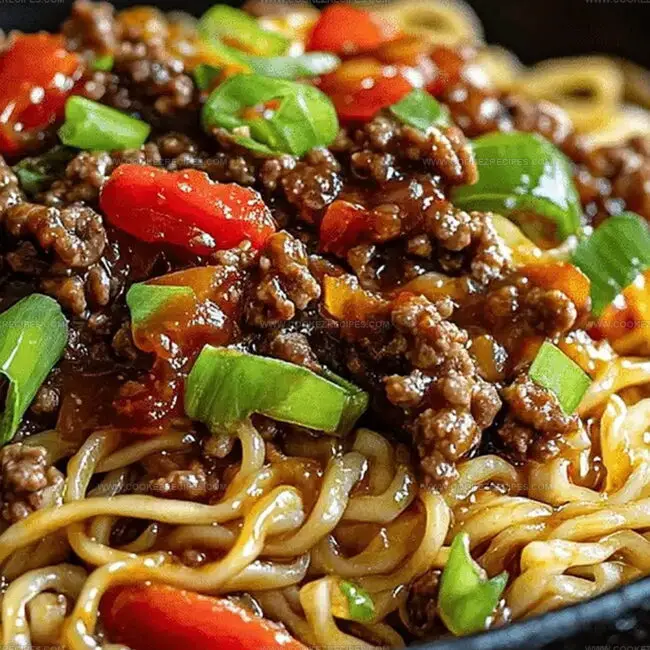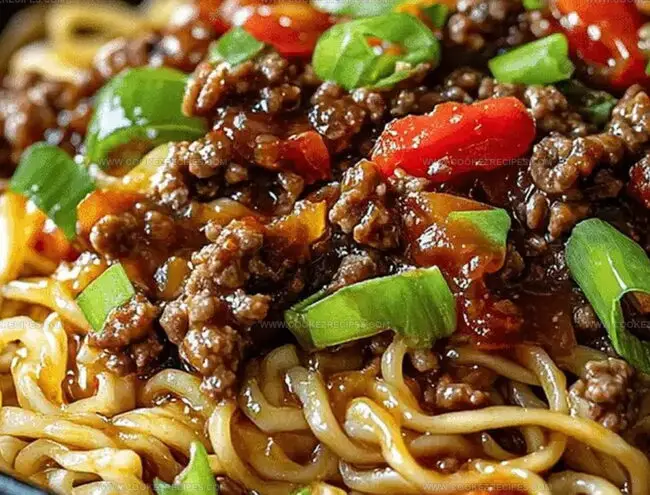Mongolian Noodles with Ground Beef Recipe for Dinner Time
Mongolian-inspired noodles with ground beef bring a delightful twist to your dinner routine.
Savory aromas will fill your kitchen as you combine these ingredients.
Tender beef mingles with silky noodles, creating a harmonious blend of flavors.
Each bite promises a journey through rich, umami-packed sensations.
Colorful vegetables add crunch and vibrancy to the dish.
Simple yet sophisticated, this recipe transforms ordinary ingredients into an extraordinary meal.
Mongolian Noodles With Ground Beef That Bring Big Flavor Fast
Ground Beef and Noodle Sauce in Mongolian Noodles
Main Ingredients:Sauce Components:Aromatics and Seasonings:Additional Ingredients:Thickening Agent:How To Cook Mongolian Noodles With Ground Beef
Step 1: Boil Noodles
Select your favorite wheat or rice noodles and cook them in rapidly boiling water.
Follow package directions carefully to ensure perfect texture.
Once cooked, drain thoroughly and set aside in a separate bowl.
Step 2: Craft Flavorful Sauce
Whisk together a robust sauce using:Blend ingredients until smooth and set aside for later use.
Step 3: Brown the Beef
Heat a large skillet or wok over medium-high heat.
Add ground beef and break into small crumbles while cooking.
Continue cooking until meat turns completely brown and develops a rich caramelized exterior.
Carefully drain any excess fat from the pan.
Step 4: Enhance Beef Flavor
Add fresh minced garlic to the browned beef.
Sauté for one minute to release aromatic flavors.
Pour prepared sauce over beef and stir thoroughly to create an even coating.
Step 5: Combine Noodles and Beef
Gently add cooked noodles into the skillet with seasoned beef.
Toss everything together until noodles are completely covered with sauce and beef is evenly distributed.
Step 6: Garnish and Serve
Transfer noodle mixture to serving plates.
Sprinkle chopped green onions on top for a fresh, bright finish.
Serve immediately while hot and enjoy the mouthwatering combination of flavors.
Noodle Tips With Mongolian Beef Flavor
Mongolian Noodles: Reheat Without Losing Texture
What Complements Mongolian Noodles
Bold Flavors in Mongolian Beef Noodle Styles
FAQs
While inspired by flavors, this dish is more of an American-Chinese restaurant creation rather than an authentic Mongolian recipe. The name comes from the bold, robust sauce style popular in Mongolian-style cooking.
Absolutely! While traditional recipes use specific noodles, you can substitute with egg noodles, udon, ramen, or even spaghetti. Just ensure they’re cooked al dente for the best texture.
The red pepper flakes provide a mild heat level. You can easily adjust the spiciness by increasing or decreasing the amount of red pepper flakes to suit your taste preference.
No special equipment is required. A standard large skillet or wok and basic kitchen utensils are sufficient to prepare this delicious noodle dish.
Print
Mongolian Noodles with Ground Beef Recipe
- Total Time: 15 minutes
- Yield: 4 1x
Description
Hearty Mongolian noodles dance with savory ground beef in this quick, flavor-packed dish that brings Asian street food directly to your kitchen. Spicy, tangy sauce coats perfectly tender noodles, creating a satisfying meal you’ll crave again and again.
Ingredients
Proteins:
- 1 pound (454 grams) ground beef
- 8 ounces (226 grams) ramen noodles (or any thin noodles)
Sauces and Seasonings:
- 1/4 cup soy sauce
- 1/4 cup hoisin sauce
- 2 tablespoons brown sugar
- 1 teaspoon sesame oil
- 1/4 teaspoon crushed red pepper flakes (optional)
- 1 tablespoon cornstarch
- 2 tablespoons water
Aromatics and Garnish:
- 3 cloves garlic, minced
- 2 green onions, chopped (for garnish)
Instructions
- Prepare a generous pot of boiling water and immerse the noodles, cooking them until they reach a tender yet firm consistency. Carefully drain and set aside, allowing them to rest.
- Create a vibrant sauce by whisking together the soy sauce, hoisin sauce, brown sugar, sesame oil, and red pepper flakes in a compact mixing bowl. Let the flavors meld while preparing the other components.
- Ignite a large skillet over medium-high heat, introducing the ground beef to the searing surface. Methodically break down the meat using a wooden utensil, ensuring even browning and thorough cooking. Eliminate any accumulated excess fat.
- Introduce minced garlic to the cooked beef, allowing it to sizzle and release its aromatic essence for approximately one minute. Cascade the prepared sauce over the meat, stirring meticulously to achieve complete coating.
- For those desiring a more robust sauce consistency, incorporate the cornstarch mixture, continuing to cook and stir until the sauce thickens and develops a glossy sheen.
- Gently fold the previously prepared noodles into the seasoned meat mixture, ensuring each strand becomes thoroughly embraced by the flavorful sauce.
- Transfer the completed dish to elegant serving plates, adorning the surface with a sprinkle of freshly chopped green onions. Present immediately while the dish maintains its optimal temperature and textural integrity.
Notes
- Transform noodle texture by slightly undercooking them before final tossing, ensuring a perfect al dente bite when mixed with hot beef sauce.
- Swap ground beef with ground turkey or plant-based crumbles for lighter, healthier protein alternatives that maintain the dish’s rich flavor profile.
- Create deeper umami depth by adding a splash of rice wine or mirin during beef cooking stage, enhancing overall sauce complexity.
- Control spice levels easily by adjusting red pepper flakes quantity, allowing customization for different heat preferences without compromising the recipe’s fundamental taste.
- Prep Time: 5 minutes
- Cook Time: 10 minutes
- Category: Dinner
- Method: Sautéing
- Cuisine: Mongolian
Nutrition
- Serving Size: 4
- Calories: 600
- Sugar: 8 g
- Sodium: 1200 mg
- Fat: 30 g
- Saturated Fat: 12 g
- Unsaturated Fat: 18 g
- Trans Fat: 1 g
- Carbohydrates: 60 g
- Fiber: 2 g
- Protein: 25 g
- Cholesterol: 80 mg




Daniel Bruns
Founder & Culinary Innovator
Expertise
Recipe development for home cooks, Nutritional analysis and meal planning, Culinary education and food writing
Education
Auguste Escoffier School of Culinary Arts
Diploma in Culinary Arts and Operations
Focus: Classical and contemporary cooking techniques, Culinary entrepreneurship and kitchen management, Menu development and food cost analysis
Daniel’s story started with flour on his face and a pie in the oven at his grandma’s house. He later sharpened his skills at the Auguste Escoffier School of Culinary Arts.
His goal? Recipes so simple you’ll want to cook every night. When he’s not whipping up one-pan wonders, Daniel’s outside picking herbs, hosting neighborhood cook-offs, or baking chocolate cakes with his kids, messy, sweet, and unforgettable.